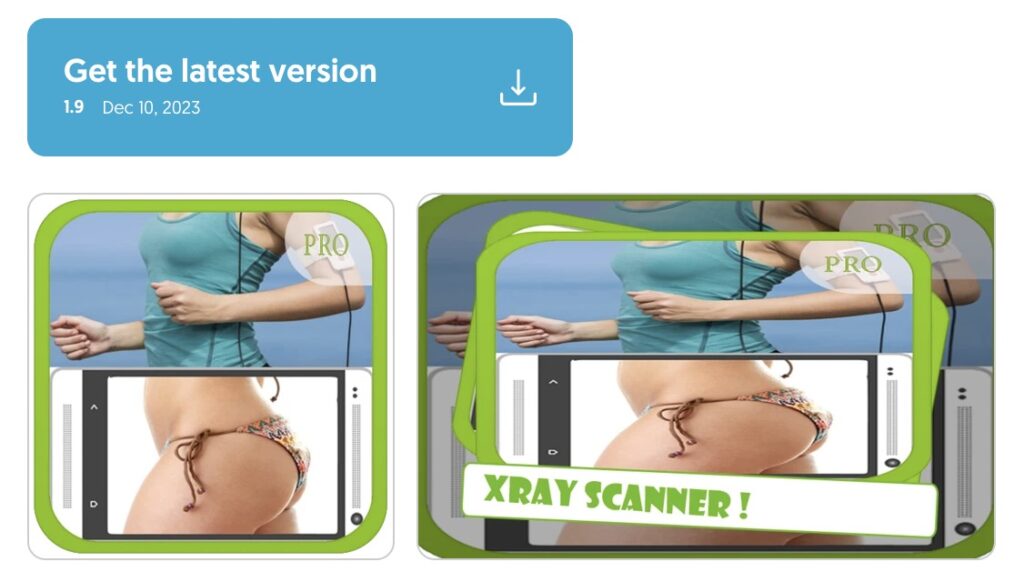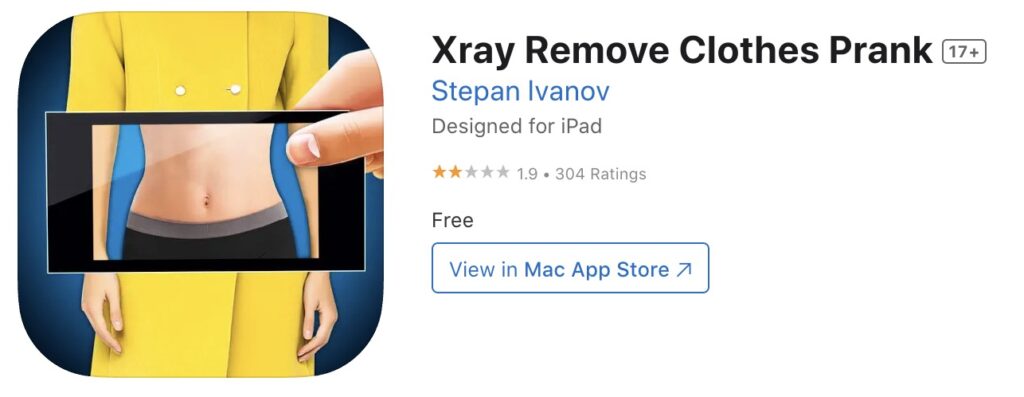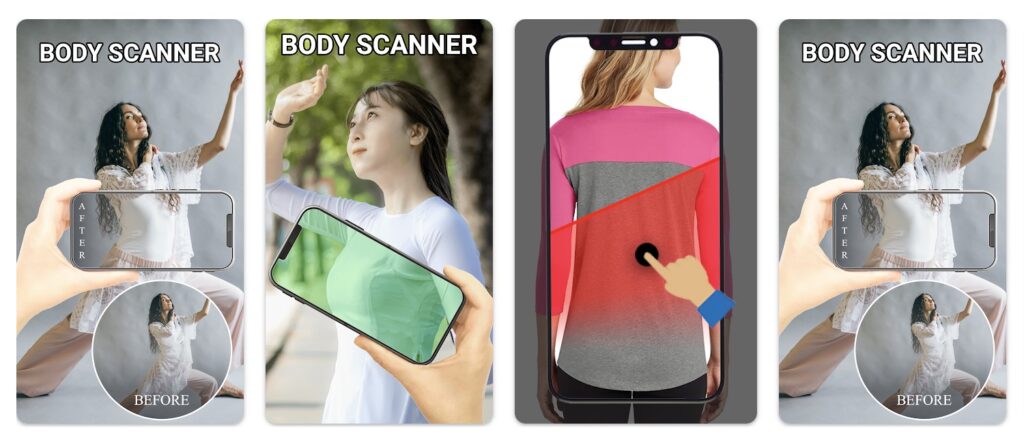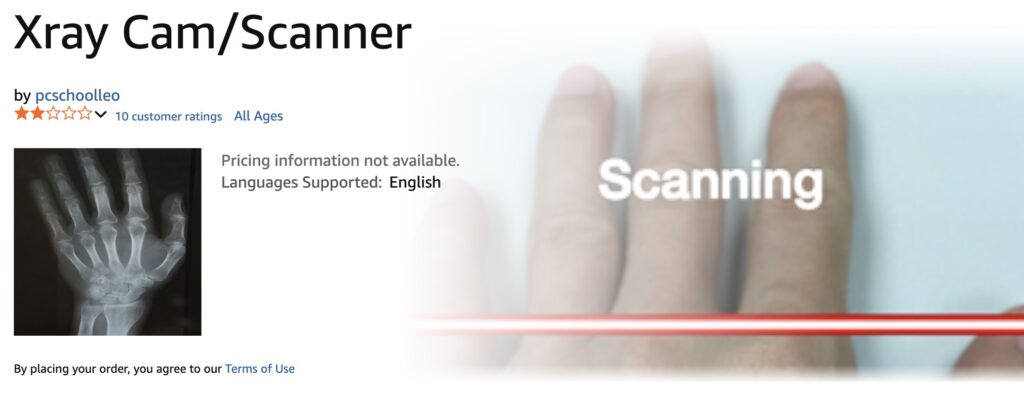Despite the increasing interest in virtual dressing rooms and photo editing technologies, it is important to clarify that no legitimate X-ray apps exist that allow users to remove clothing from images without significant ethical, legal, and privacy concerns, especially given the advancements in augmented reality.
Many claims about these apps arise from misunderstandings about augmented reality and image manipulation technologies, which are primarily designed to enhance user experience without compromising privacy or consent. These apps often promise impressive software features but fail to address user safety adequately.
As more consumers embrace these advanced tools for trying on outfits or customizing their looks digitally, it is essential to understand the limitations and boundaries of such applications, especially in terms of digital privacy and user consent.
While augmented reality is undeniably innovative, it does not possess the invasive capabilities that some misconceptions imply. The fashion industry must prioritize user trust by transparently outlining how these technologies handle personal data, securing informed consent, and addressing any potential misuse or exploitation of images.
Ultimately, it is not merely about the features offered but also about fostering a respectful relationship with consumers, ensuring that their privacy is upheld while they enjoy the benefits of fashion technology.
Best X-ray AI Apps
- OkBra App – Try For Free
- Undress App
- DeepNude App
- Nudify.online
- BraUndress Bot
Best X-ray Prank Apps
#1 Remove Clothes Xray Real Prank v 1.9 by Pro Apps Games

#2 Xray Remove Clothes Prank [17+] by Stepan Ivanov

#3 Full Audery Body Scanner Xray by Revelon LLC

#4 Xray Cam/Scanner by pcschoolleo

#5 X-ray Scanner body
#6 See-Through Camera
#7 X-ray Scanner Simulator
#8 Xray Simulator Scan
#9 X-ray Scan simulator
#10 Camera X-Ray Clothes Joke
#11 Wall Scanner See Through Walls
I recommend trying each app because they all have quite different functionality.
Ethical Concerns of X-ray Apps
The potential misuse of clothing removal functionalities in X-ray apps raises significant ethical concerns for me, as these features can be exploited for unethical purposes such as invading personal privacy and generating unauthorized images without consent. Additionally, the use of artificial intelligence in these apps can amplify these issues.
This troubling trend paves the way for harassment and cyberbullying, placing users at risk of becoming victims to those who may take advantage of these functionalities, thereby highlighting the importance of content moderation. Such malicious uses undermine the safety and dignity of individuals and contribute to an environment filled with intimidation and fear.
As more individuals engage with these technologies, the repercussions extend beyond personal distress, underscoring the urgent need for comprehensive privacy regulations, such as GDPR and CCPA. Establishing robust guidelines to govern app functionality is essential in ensuring that users’ rights are protected and that ethical boundaries are maintained in a digital landscape that increasingly exhibits vulnerability.
Privacy Violations in X-ray Apps
The use of X-ray apps raises significant concerns regarding user privacy, as these smartphone apps frequently violate consent protocols and disregard digital privacy standards by exposing sensitive information without users’ awareness.
This situation underscores the critical need for robust privacy policies and stringent data security measures in smartphone applications. For instance, when users unknowingly grant these apps access to their camera or location data, their personal information can be harvested and misused, potentially leading to identity theft or harassment.
Privacy breaches can have serious legal repercussions for app developers, including lawsuits and fines imposed by regulatory bodies. These consequences highlight the importance of prioritizing transparency and user consent, ensuring that individuals are fully informed about how their data is collected, used, and safeguarded. Emphasizing digital ethics is crucial for responsible software development and user trust.
The Cyberbullying Threat from X-ray Apps
The rise of X-ray apps and similar technologies can unintentionally contribute to cyberbullying, as individuals may misuse these tools to create and share unauthorized images that infringe on others’ privacy on social media platforms. Such actions compromise online safety and user privacy significantly.
This trend prompts urgent discussions around personal ethics and responsibility, particularly in terms of how sensitive technologies are utilized. The ease with which information can be manipulated and spread online can lead to damaging behaviors that target vulnerable individuals, exposing them to ridicule or harassment.
As this issue continues to escalate, it underscores the critical need for strong community guidelines to protect users from such violations of privacy. Establishing clear protocols for responsible usage and raising awareness about the potential consequences of digital harassment are essential steps toward fostering a safer online environment.
This approach can encourage users to engage with one another in a more ethical and empathetic manner.
Psychological Impacts of X-ray Apps on Self-Image
I recognize that the psychological impact of the use of X-ray applications, especially concerning perceptions of nudity and the reinforcement of unrealistic body standards, can lead to significant mental health challenges among users, particularly adolescents.
These young individuals, already navigating the complex landscape of self-identity during their formative years, may experience increased strain on their self-esteem due to comparisons with digitally altered images, especially when manipulated through photo editing and augmented filters. When manipulated visuals become the standard, it creates a disconnect between reality and expectation, making it difficult for users to appreciate their own unique bodies.
The discussions surrounding ethical technology have highlighted the critical need for consent in the creation and sharing of such content, underscoring the importance of cultivating healthier digital environments. By prioritizing transparency and respect for personal boundaries, society can begin to mitigate the negative effects of these technologies and promote positive body image and self-acceptance. Implementing user feedback mechanisms can help in refining these technologies.
Inaccuracies in X-ray Applications
While I have observed that some X-ray apps claim to accurately simulate clothing removal, they frequently fail to deliver reliable results, often due to inherent limitations in their image processing algorithms. This often leads to inaccuracies in image manipulation and, subsequently, disappointment among users, impacting their overall user experience.
These applications tend to have difficulty capturing the intricate details of clothing textures and the nuances of different fabric types, which can result in a distorted portrayal of the human form. Users may notice that the textures appear unnatural or overly smoothed, creating a stark contrast with the surrounding elements in the image. This highlights the need for better filter effects in these applications.
Such discrepancies not only misrepresent the subject but can also foster unrealistic expectations regarding the capabilities of visual media.
Ultimately, this draws attention away from genuine photographic artistry and can leave users feeling misled, particularly when they rely on these tools for significant decisions related to fashion or personal presentation. Enhanced image recognition and real-time processing are essential for improving these applications.
Vulnerabilities in X-ray Applications: Exploitation Risks by Hackers
X-ray applications that leverage advanced image recognition and transformation technologies can unfortunately become appealing targets for hackers, who may seek to exploit vulnerabilities to gain access to private user data or unlawfully manipulate images.
This situation raises significant concerns regarding data security, especially as more individuals depend on these applications for health-related assessments. Ensuring robust application security must be a top priority to prevent potential exploitations. An atmosphere of uncertainty surrounding user privacy becomes apparent, highlighting the urgent need for stringent privacy regulations to protect personal data.
Regulations such as the General Data Protection Regulation (GDPR) establish a framework for the proper handling of user information, ensuring that individuals maintain rights over their personal data. Compliance with privacy laws is non-negotiable in this context.
Additionally, the importance of app reviews cannot be overstated. By analyzing feedback and experiences shared by users, individuals can more effectively identify secure applications that prioritize their safety and responsibly manage their private information.
Legal Implications of Unauthorized Use of X-ray Applications
The unauthorized use of X-ray apps for clothing removal can lead to serious legal repercussions, particularly when consent is not secured and digital privacy laws are violated. This can severely impact the user demographics who may be unaware of these risks.
Such actions can result in serious lawsuits, where individuals may seek restitution for emotional distress or invasion of privacy. The implications of utilizing these apps extend beyond personal accountability; companies developing such technology must also consider their ethical responsibilities.
These organizations play a crucial role in shaping user behavior by promoting respect for privacy and fostering a culture of consent. Machine learning algorithms used in these apps must be carefully designed to avoid algorithmic bias. By prioritizing ethical technology, developers can encourage responsible use and minimize the risks associated with potential legal repercussions.
Perpetuation of Unrealistic Body Standards
The normalization of X-ray apps has the potential to perpetuate unrealistic body standards by presenting manipulated images as representations of beauty. This significantly impacts my mental health, especially when I find myself comparing my appearance to these altered visuals. Addressing the ethical implications of such apps is critical in this context.
I often experience an internal struggle, feeling inadequate or dissatisfied with how I look. Social media platforms play a crucial role in this phenomenon, as they frequently highlight curated images that reinforce an idealized sense of beauty.
The effects of these altered images are profound, shaping societal perceptions in ways that foster insecurity and diminish self-esteem. Social media further amplifies these issues through user-generated content. To combat this trend, I recognize the importance of image authenticity and actively resist visual manipulation. Encouraging creative expression and ethical design in technology can help promote healthier standards.
This is particularly crucial in the realms of creativity and fashion, where digital photography and genuine representations can give the power to individuals, including myself, to embrace our unique selves through photo manipulation and technology trends.
Objectification of Individuals Through Mobile Applications
The use of X-ray apps raises significant ethical concerns, as they can lead to the objectification of individuals by reducing them to mere images and altering their physical appearance without consent management. This not only impacts user experience but also affects the portrayal of identity protection.
This issue goes beyond visuals and interactive features; it also encroaches upon privacy and self-expression. When technology is employed to manipulate someone’s appearance without their agreement, it undermines personal autonomy and promotes a culture where individuals are viewed as objects rather than as people with inherent dignity and consent.
Such practices can have profound implications for mental health and societal standards of beauty and visual effects. Therefore, it is essential to advocate for ethical technology practices that prioritize consent and recognize user agency, ensuring that technologies enhance human interaction rather than diminish it through artificial intelligence ethics.
Why Do People Believe These Apps Exist in Mobile Technology?
The belief in the existence of X-ray apps can often be linked to psychological factors, societal trends, and the appeal of fashion technology highlighted in entertainment apps and app monetization strategies that advocate for quick fixes to complex issues such as body image enhancement and nudity detection.
This fascination is not merely a whimsical idea; it underscores deep-seated psychological needs for validation and acceptance in a society that frequently emphasizes superficial appearances. As media portrayals glamorize unrealistic beauty standards through branding strategies, individuals may turn to tools that promise instant results, which can lead to misconceptions about what these technologies can actually accomplish.
Entertainment apps often intensify this misunderstanding by presenting a distorted reality where every flaw can be effortlessly filtered or edited away using image enhancement techniques.
As a result, this environment fosters a skewed perception of technology adoption, particularly regarding the true capabilities of X-ray apps. This perpetuates unrealistic expectations and further entrenches societal pressures related to body image and digital footprint concerns.
Possible Risks of Using X-ray Apps and Privacy Implications
Utilizing X-ray apps presents several significant risks, including the violation of user privacy, potential psychological harm stemming from unrealistic imagery through clothing detection, and the increased likelihood of becoming a target for cyberbullying or online harassment. Understanding these risks is crucial for responsible technology use.
These applications frequently require access to sensitive personal information or image data through user profiles, which poses a considerable risk of privacy breaches if not sufficiently safeguarded. Users may encounter distorted or unrealistic representations of themselves, which can contribute to negative self-image and anxiety regarding their appearance and sensory perception.
For example, a teenager using an X-ray app to enhance their photos might subsequently face bullying when peers perceive the altered image as a standard to aspire to, resulting in feelings of inadequacy. Instances of online harassment linked to manipulated images underscore the necessity of comprehending these potential consequences before choosing to engage with such applications and user outreach strategies.
Protecting Against Risks of X-ray Apps: The Role of Parental Controls
Protecting myself from the potential risks associated with X-ray apps and digital innovation requires a comprehensive understanding of digital privacy rights, a commitment to advocating for ethical technology development, and a proactive approach to my own privacy and consent management.
To effectively safeguard my digital footprint, I begin by thoroughly reviewing privacy policies before downloading any application and considering regulation compliance. This practice guarantees that I fully understand what personal data is collected and its intended use.
I also make it a priority to opt out of data sharing whenever possible, adding an extra layer of protection and enabling greater control over my personal information and user habits. I seek out applications that prioritize user consent, as these platforms often reflect a strong commitment to privacy settings.
Furthermore, familiarizing myself with privacy regulations such as GDPR or CCPA gives the power to me by clarifying my rights and the obligations of companies to protect my data through risk management.
Ethical Alternatives to X-ray Apps for User Engagement
Instead of depending on controversial X-ray apps, I prefer to explore ethical fashion apps and digital editing tools that enhance photos while respecting user privacy and promoting a positive user experience through photography tools.
For example, I find apps like Good On You particularly valuable as they provide ratings for fashion brands based on their ethical practices and sustainability efforts, reflecting trusted branding strategies. This allows me to make informed choices that align with my values.
Similarly, I appreciate platforms like Canva, which offer digital editing capabilities with a user-friendly design focus, ensuring that creative expression is accessible without compromising personal information through user interface improvements.
These alternatives not only enable me to express myself and support ethical fashion, but they also foster a safe environment where privacy is prioritized through consumer protection measures. This enhances my overall experience while allowing me to avoid questionable practices.
Educating Others on X-ray Apps: Promoting Digital Literacy and Critical Thinking
Educating others about the risks associated with X-ray apps is essential for promoting digital literacy, fostering ethical technology use, and empowering users to make informed decisions regarding their online activities and software trends.
To achieve this, I believe community workshops can serve as effective platforms for online behavior education where individuals can engage in discussions, ask questions, and gain insights into the implications of these technologies. Additionally, leveraging social media campaigns allows for wider awareness. Utilizing visually appealing content and relatable narratives helps capture attention and enhances application store visibility.
Forming partnerships with organizations that advocate for digital privacy will further amplify these efforts, creating a united front that supports user empowerment and trustworthiness.
By taking these steps, I can contribute to cultivating an informed community that values privacy, engages in content creation, and actively participates in safeguarding their digital lives through user education initiatives.
Popular keywords:
x-ray cloth remover
x-ray cloth scanner real app download
best x ray cloth remover
female body scanner app
girl body x ray app download
x ray app real
spyglass app clothes apk
x ray cloth scanner online
x ray cloth remover
xray app clothes free
women xray app clothes
best xray app clothes
xray app clothes for android
Frequently Asked Questions
What are X-ray Remove Clothes Apps?
X-ray Remove Clothes Apps are mobile applications that claim to use X-ray technology to remove clothing from photos or videos of individuals, revealing their naked bodies. These apps are often marketed as entertainment or prank apps, but can also be used for malicious purposes.
How do X-ray Remove Clothes Apps work?
Most X-ray Remove Clothes Apps use a simple editing trick, such as superimposing a pre-rendered image of a naked body over clothing in a photo or video. Some apps may also use artificial intelligence or machine learning algorithms to simulate an X-ray effect.
Are X-ray Remove Clothes Apps real?
No, X-ray Remove Clothes Apps are not real. They cannot actually see through clothing or reveal a person’s naked body. They are simply using advanced editing techniques to create a fake X-ray effect.
Are X-ray Remove Clothes Apps legal?
The legality of X-ray Remove Clothes Apps varies by country and context. In some places, these apps may be considered a form of cyberbullying or harassment and could result in legal consequences. It is important to use these apps ethically and with consent from all parties involved.
Can X-ray Remove Clothes Apps be used for non-consensual purposes?
Unfortunately, yes. X-ray Remove Clothes Apps can be used to manipulate or edit photos or videos without the knowledge or consent of the person in the image. This can lead to serious privacy and security concerns. It is important to use these apps responsibly and for entertainment purposes only.
What are the potential dangers of using X-ray Remove Clothes Apps?
Aside from the ethical concerns, using X-ray Remove Clothes Apps may also pose a security risk. These apps often require access to a user’s device and personal information, which could be compromised. They may also contain malware or viruses that can harm a user’s device. It is important to carefully research and consider the risks before downloading and using these apps.
Disclaimer: Users should be aware of the ethical implications of using X-ray Remove Clothes Apps, as they can violate privacy and consent.
